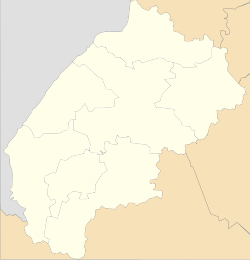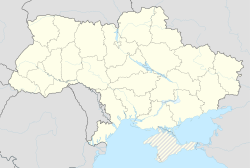Kulchytsi
Kulchytsi
Кульчиці | |
|---|---|
 | |
 Kulchytsi | |
| Coordinates: 49°30′18″N 23°16′45″E / 49.50500°N 23.27917°ECoordinates: 49°30′18″N 23°16′45″E / 49.50500°N 23.27917°E | |
| Country | |
| Province | |
| District | |
| Established | 1284 |
| Area | |
| • Total | 254 km2 (98 sq mi) |
| Elevation /(average value of) | 307 m (1,007 ft) |
| Population | |
| • Total | 1,639 |
| • Density | 64.530/km2 (167.13/sq mi) |
| Time zone | UTC+2 (EET) |
| • Summer (DST) | UTC+3 (EEST) |
| Postal code | 81476 |
| Area code | +380 3236 |
| Website | село Кульчиці(Ukrainian) |
Kulchytsi (Ukrainian: Ку́льчиці, historic name — Кульчачке, Кольчиці, Polish: Kulczyce[1]) is a village (selo), which is located in Sambir Raion, Lviv Oblast, of Western Ukraine. It belongs to , one of the hromadas of Ukraine.[2]
The estimated population is around 1,639. Local government is administered by Kulchytska village council.[3]
Geography[]
The village is situated on the hilly area at a distance 8 kilometres (5.0 mi) from the district center Sambir. It is situated in the 83 kilometres (52 mi) from the regional center Lviv and 29 kilometres (18 mi) from the city Drohobych.
History[]
Archaeological excavations have revealed traces of settlements from the 5th to 4th centuries BC, although the official founding date of village is 1284.[4] Thirteen Stone-Age burial mounds (late 3rd millennium BC) near Kulchytsi were investigated. The settlement beginning Iron Age (about the 7th or 6th century BC) have been preserved in territory of village
A historic name of the village was Kulchachke (Кульчачке; Ukrainian) of Tatar origin.
Religious structures and attractions[]
Christians have an opportunity to visit the Exaltation of the Holy Cross Orthodox Church, Church of the Transfiguration and Church of Saints Florus and Laurus.
In the village has an architectural monument of local importance of Sambir Raion (Sambir district).[5] It is a wooden bell tower of Church of Florus and Laurus 18th century (499-М).
Church of Saints Florus and Laurus
Exaltation of the Holy Cross Orthodox Church

A newly built wooden Church of the Transfiguration.
Museums and monuments[]
Village residents know and want to learn of the history of the village and land. Valuable historical and architectural attractions been saved in the village. This is museum by name Hetman Sahaidachny,[6] a monument to Hetman Petro Sahaidachny, Yuri-Franz Kulchytsky monument, a wooden Bell tower of Church of Florus and Laurus 18th century and other.
The idea of the museum foundation appeared in 1992, when the monument to Petro Konashevych-Sahaydachny was opened. It was decided to found the museum in the native village of the Ukrainian Hetman who had played the most important part in the history of Ukrainian Cossacks. Museum Director Bogdan Sydor[7] is one of the founders of the museum.[8]

Equestrian of Petro Konashevych-Sahaidachny
Museum by name Petro Konashevych-Sahaidachny
Jerzy Franciszek Kulczycki monument
Famous people[]
- Petro Konashevych-Sahaidachny (1570-1622) — Otaman Cossack Army, Getman his the Royal grace Zaporizhia Army. He was an outstanding figure in Ukraine's history, a major political leader and statesman, the leader of the Cossack Regiment and one of the founders of the Kyiv Brotherhood. He played an important role in the life of the Ukrainian Orthodox Church and the university, Kyiv-Mohyla Academy.
- Marko Zhmaylo-Kulchytskyy — Registered Cossacks Hetman (1625), leader of the peasant-Cossack Zhmaylo Uprising in 1625.
- Jerzy Franciszek Kulczycki (1640-1694) — Polish political and civic leader, coffee businessman

Petro Konashevych-Sahaidachny
Jerzy Franciszek Kulczycki
References[]
- ^ Kulczyce (in Polish)
- ^ "Ралівська територіальна громада" (in Ukrainian). decentralization.gov.ua.
- ^ Kulchytska village council
- ^ Село Кульчиці: карта вулиць, фото (in Ukrainian)
- ^ Пам'ятки архітектури Самбірського району (in Ukrainian)
- ^ Museum of HETMAN SAHAYDACHNY
- ^ Музей Петра Сагайдачного в Кульчицях (in Ukrainian)
- ^ Cossack News in Ukraine/ page 10/ 2011-06-07 The Ukrainian Registered Cossacks honor the memory of Hetman Petro Sagaidachny
External links[]
- Село Кульчиці (in Ukrainian)
- "КУЛЬЧИЦІ - Гетьманське село над Дністром" » Історія села Кульчиці (in Ukrainian)
- Kulchytsi – Wikimapia
- Кульчиці, Свв. Флора і Лавра 1904 (in Ukrainian)
- Cossack Web Museum, Hetman Sahaidachny
- KARPATY.INFO/Traveling in the Carpathians and around/Western Ukraine/Lviv region/Sambir district/Kulchytsi: (in Ukrainian)
- KARPATY.INFO/Museum of HETMAN SAHAYDACHNY
Literature[]
- (in Ukrainian) History of Towns and Villages of the Ukrainian SSR, Lvov region. – Київ : ГРУРЕ, 1968 р., Page 834.
- (in Ukrainian) Богдан Сидор, Подільці і подільчани - Самбір, 2008.
- Villages in Sambir Raion









